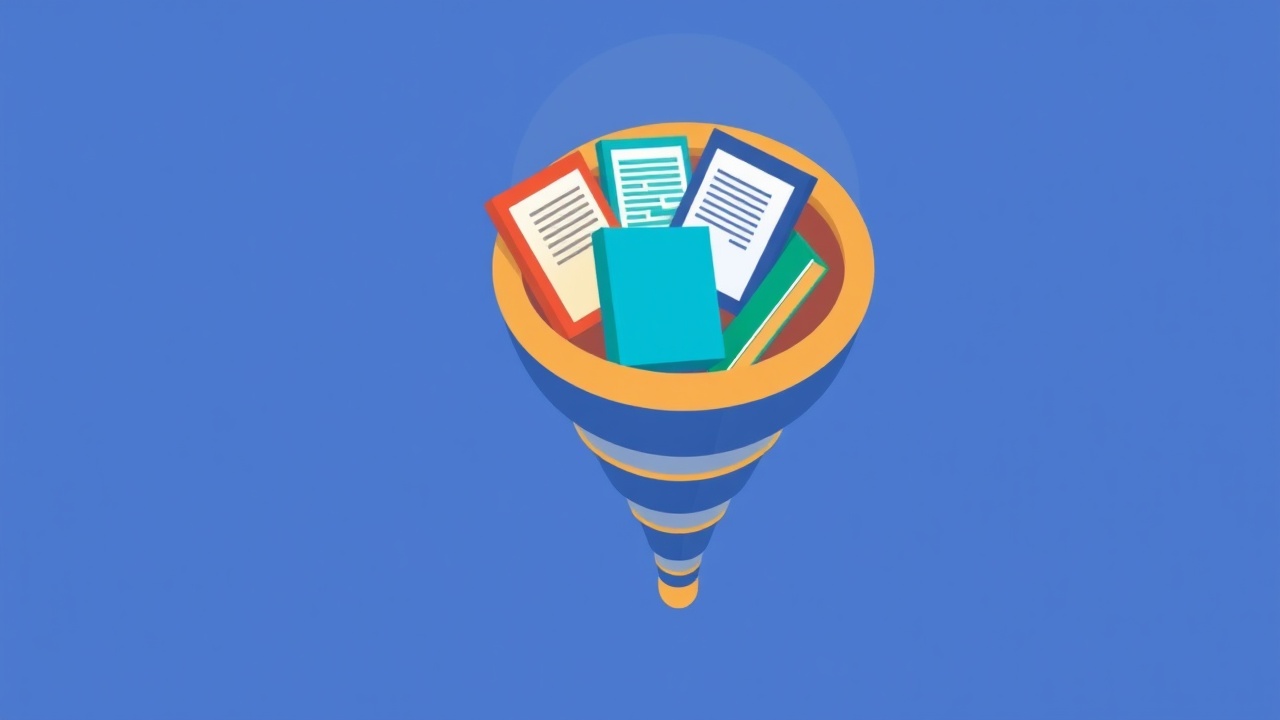Building an Effective Marketing Funnel with E-Books

The marketing funnel is a conceptual framework that illustrates the journey potential customers take from the moment they become aware of a product or service to the point of making a purchase. This journey is typically divided into several stages: awareness, interest, consideration, intent, evaluation, and purchase. Each stage represents a different level of engagement and commitment from the consumer, and understanding this progression is crucial for marketers aiming to optimize their strategies.
The funnel metaphor is particularly effective because it visually represents how a large number of potential customers enter the top of the funnel but only a fraction make it to the bottom, where conversion occurs. At the top of the funnel, marketers focus on generating awareness through various channels such as social media, content marketing, and paid advertising. This stage is characterized by broad outreach efforts aimed at attracting a wide audience.
As prospects move down the funnel, they begin to show interest in specific products or services, often seeking more information. This is where targeted content becomes essential; it helps to nurture leads by providing valuable insights that address their needs and pain points. Understanding the nuances of each stage allows marketers to tailor their messaging and tactics effectively, ensuring that they guide potential customers smoothly through the funnel.
Key Takeaways
- The marketing funnel is a model that represents the customer journey from awareness to purchase.
- Compelling e-books can be created by providing valuable and relevant content to the target audience.
- E-books can be used to generate leads by offering them as gated content in exchange for contact information.
- Nurturing leads through the funnel involves providing personalized and targeted content to move them closer to making a purchase.
- Converting leads into customers can be achieved by using e-books to showcase the value of your products or services and addressing any objections.
Creating Compelling E-Books
E-books have emerged as a powerful tool in digital marketing, serving as both lead magnets and educational resources. To create an effective e-book, it is essential to focus on delivering high-quality content that resonates with your target audience. This begins with thorough research to identify topics that are not only relevant but also engaging for your readers.
For instance, if you are in the health and wellness industry, an e-book titled “10 Essential Habits for a Healthier Lifestyle” could attract individuals looking to improve their well-being. The key is to provide actionable insights and practical tips that readers can implement in their daily lives.
In addition to content quality, the design and presentation of the e-book play a significant role in its effectiveness.
A visually appealing layout with professional graphics, charts, and images can enhance the reading experience and keep readers engaged. Incorporating interactive elements such as hyperlinks to additional resources or embedded videos can further enrich the content. Moreover, ensuring that the e-book is optimized for various devices—such as tablets, smartphones, and desktops—will make it accessible to a broader audience.
By combining compelling content with an attractive design, marketers can create e-books that not only capture attention but also encourage readers to share them within their networks.
Generating Leads with E-Books
E-books serve as an effective lead generation tool by offering valuable information in exchange for contact details. To maximize lead generation efforts, marketers should strategically position their e-books on landing pages where visitors can easily access them. This often involves creating enticing calls-to-action (CTAs) that highlight the benefits of downloading the e-book.
For example, a CTA might read, “Download our free e-book to discover proven strategies for increasing your productivity!” By clearly articulating what readers will gain from the e-book, marketers can significantly increase conversion rates. Once potential leads download the e-book, it is crucial to follow up with them promptly. This can be achieved through automated email sequences that thank them for their interest and provide additional resources related to the e-book’s content.
For instance, if the e-book covers social media marketing strategies, subsequent emails could include links to blog posts or webinars that delve deeper into specific tactics mentioned in the e-book. This not only keeps leads engaged but also positions your brand as a knowledgeable authority in your industry, fostering trust and encouraging further interaction.
Nurturing Leads through the Funnel
Nurturing leads through the marketing funnel requires a strategic approach that focuses on building relationships over time. After capturing leads through e-books or other means, marketers should implement a multi-channel communication strategy that includes email marketing, social media engagement, and personalized content delivery. Email marketing remains one of the most effective ways to nurture leads; by segmenting your audience based on their interests and behaviors, you can tailor your messaging to meet their specific needs.
For example, if a lead downloaded an e-book about digital marketing trends, sending them case studies or success stories related to those trends can keep them engaged. In addition to email communication, leveraging social media platforms can enhance lead nurturing efforts. Engaging with leads through comments, direct messages, or even targeted ads can create a sense of community and encourage ongoing dialogue.
Providing valuable content consistently—whether through blog posts, videos, or infographics—can help maintain interest and keep your brand top-of-mind as leads progress through the funnel. The goal during this nurturing phase is to provide value at every touchpoint while gradually guiding leads toward making informed purchasing decisions.
Converting Leads into Customers
The conversion stage of the marketing funnel is where all previous efforts culminate in turning leads into paying customers. To facilitate this transition effectively, marketers must ensure that their sales process is seamless and user-friendly. This often involves optimizing landing pages for conversions by minimizing distractions and clearly outlining the benefits of purchasing a product or service.
For instance, including testimonials or case studies on product pages can provide social proof that reassures potential customers about their decision. Additionally, employing urgency tactics—such as limited-time offers or exclusive discounts—can create a sense of urgency that encourages leads to take action sooner rather than later. For example, an e-book on financial planning could be accompanied by a special offer for a consultation service available only for those who downloaded the e-book within a specific timeframe.
By combining persuasive messaging with strategic offers, marketers can significantly increase their conversion rates and turn interested leads into loyal customers.
Upselling and Cross-selling with E-Books
Once customers have made a purchase, there remains an opportunity for businesses to enhance their revenue through upselling and cross-selling strategies. E-books can play a pivotal role in this process by providing additional value that complements existing purchases. For instance, if a customer buys an online course about graphic design, offering an e-book titled “Advanced Graphic Design Techniques” can entice them to invest further in their education while reinforcing their commitment to your brand.
Moreover, creating bundled offers that include both products and relevant e-books can be an effective way to increase average order value. For example, a fitness company might offer a package that includes workout gear along with an e-book on nutrition tips for athletes. This not only provides customers with comprehensive solutions but also positions your brand as a one-stop shop for all their needs.
By leveraging e-books strategically in upselling and cross-selling efforts, businesses can maximize customer lifetime value while enhancing overall satisfaction.
Retaining Customers with E-Books
Customer retention is critical for long-term business success, and e-books can be instrumental in fostering loyalty among existing customers. Providing ongoing educational resources helps reinforce the value of your products or services while keeping customers engaged with your brand. For instance, after a customer purchases software for project management, offering them an e-book on best practices for team collaboration can enhance their experience and encourage them to continue using your product.
Additionally, creating exclusive e-books for loyal customers can strengthen relationships and incentivize repeat purchases. These exclusive resources could include advanced tips or insider knowledge that regular customers do not have access to.
By making customers feel valued through personalized content offerings, businesses can cultivate loyalty and encourage word-of-mouth referrals—an invaluable asset in today’s competitive marketplace.
Analyzing and Optimizing the Funnel
To ensure ongoing success in leveraging e-books within the marketing funnel, continuous analysis and optimization are essential. Marketers should regularly review key performance indicators (KPIs) such as download rates, conversion rates, and customer feedback to assess the effectiveness of their strategies. Tools like Google Analytics can provide insights into user behavior on landing pages and help identify areas for improvement.
A/B testing different elements—such as CTAs, landing page designs, or email subject lines—can yield valuable data on what resonates best with your audience. For example, testing two different headlines for an e-book landing page may reveal which version drives more downloads. Additionally, gathering feedback directly from customers through surveys or interviews can provide qualitative insights that inform future content creation efforts.
By adopting a data-driven approach to analyzing and optimizing the marketing funnel, businesses can refine their strategies over time and ensure they remain responsive to changing customer needs and preferences.
FAQs
What is a marketing funnel?
A marketing funnel is a model that represents the customer journey from awareness to purchase. It is divided into stages such as awareness, interest, consideration, intent, and purchase.
What is an e-book?
An e-book is a digital book that can be read on electronic devices such as e-readers, tablets, and smartphones. It is often used for educational or promotional purposes.
How can e-books be used in a marketing funnel?
E-books can be used at various stages of the marketing funnel to attract, engage, and convert potential customers. They can be used as lead magnets to capture email addresses, provide valuable information to build trust, and persuade prospects to make a purchase.
What are the benefits of using e-books in a marketing funnel?
Using e-books in a marketing funnel can help businesses establish authority, generate leads, nurture relationships with prospects, and ultimately drive sales. E-books can also be cost-effective and scalable marketing tools.
How can businesses create an effective marketing funnel with e-books?
To create an effective marketing funnel with e-books, businesses should identify their target audience, create valuable and relevant e-book content, promote the e-books through various channels, capture and nurture leads, and analyze the funnel’s performance to make improvements.

 All Products
All Products Bundle
Bundle Graphics
Graphics T-Shirt
T-Shirt Video
Video AI
AI Font
Font Presets
Presets Courses
Courses E-Book
E-Book Images
Images Music
Music Software
Software